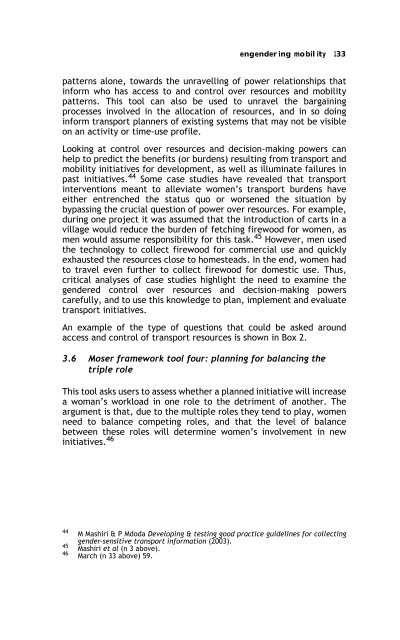Sex, Gender, Becoming - PULP
Sex, Gender, Becoming - PULP
Sex, Gender, Becoming - PULP
You also want an ePaper? Increase the reach of your titles
YUMPU automatically turns print PDFs into web optimized ePapers that Google loves.
engendering mobility 133<br />
patterns alone, towards the unravelling of power relationships that<br />
inform who has access to and control over resources and mobility<br />
patterns. This tool can also be used to unravel the bargaining<br />
processes involved in the allocation of resources, and in so doing<br />
inform transport planners of existing systems that may not be visible<br />
on an activity or time-use profile.<br />
Looking at control over resources and decision-making powers can<br />
help to predict the benefits (or burdens) resulting from transport and<br />
mobility initiatives for development, as well as illuminate failures in<br />
past initiatives. 44 Some case studies have revealed that transport<br />
interventions meant to alleviate women’s transport burdens have<br />
either entrenched the status quo or worsened the situation by<br />
bypassing the crucial question of power over resources. For example,<br />
during one project it was assumed that the introduction of carts in a<br />
village would reduce the burden of fetching firewood for women, as<br />
men would assume responsibility for this task. 45 However, men used<br />
the technology to collect firewood for commercial use and quickly<br />
exhausted the resources close to homesteads. In the end, women had<br />
to travel even further to collect firewood for domestic use. Thus,<br />
critical analyses of case studies highlight the need to examine the<br />
gendered control over resources and decision-making powers<br />
carefully, and to use this knowledge to plan, implement and evaluate<br />
transport initiatives.<br />
An example of the type of questions that could be asked around<br />
access and control of transport resources is shown in Box 2.<br />
3.6 Moser framework tool four: planning for balancing the<br />
triple role<br />
This tool asks users to assess whether a planned initiative will increase<br />
a woman’s workload in one role to the detriment of another. The<br />
argument is that, due to the multiple roles they tend to play, women<br />
need to balance competing roles, and that the level of balance<br />
between these roles will determine women’s involvement in new<br />
initiatives. 46<br />
44 M Mashiri & P Mdoda Developing & testing good practice guidelines for collecting<br />
gender-sensitive transport information (2003).<br />
45<br />
Mashiri et al (n 3 above).<br />
46 March (n 33 above) 59.
















